Seeing is Believing
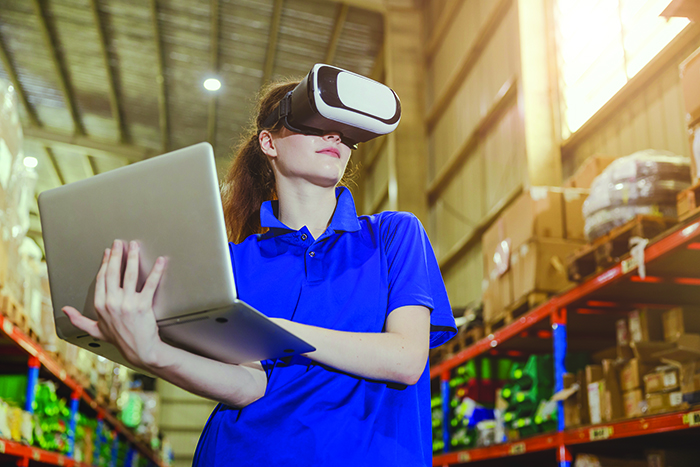 |
| istockphoto.com |
Augmented and virtual reality will solve training, picking problems for distributors.
by Kim Phelan
Like the mobile phone phenomenon of the early 2000s, the No. 1 driver of adoption may come down to one simple thing: Consumers. Workers probably won’t feel comfortable putting on VR/AR headgear until they’ve embraced the technology in their private (gaming) lives at home. When the technology evolves to become a little more mainstream, the adoption in warehouse work will follow, as will the competition to work out the bugs, work down the price, and demonstrate the ROI to distributor decision-makers.
The February release of Apple Vision Pro is a good example and may prove to be a test of the public’s appetite for something it doesn’t know it wants till people experience it. Apple is also betting big on businesses using the new product. In the company’s most recent earnings report, Apple CEO Tim Cook cited ideas for business like everyday productivity, collaborative product design, and training.
“The public isn’t focused on, ‘What am I going to get out of this.’ They’re more concerned about, ‘Hey, everybody else has this,’” said Lucas Systems Chief Technology Officer Mark McCleary. “I remember when the iPhone 1 came out — it was a pretty amazing piece of technology. That wanting what’s new feeling is what will drive [VR] technology to be developed further, and you’ll have this kind of competition amongst equipment manufacturers to make it better, lighter, and faster. And then it’ll get to a point where the ROI inside the warehouse makes sense.
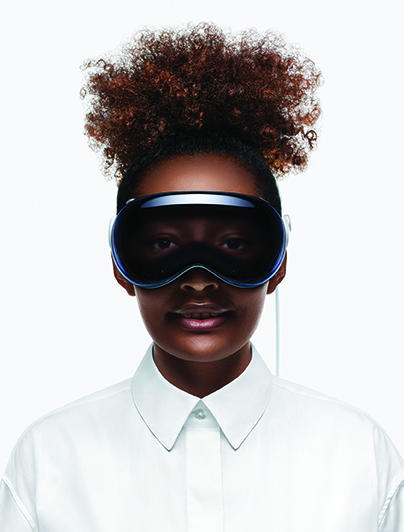 |
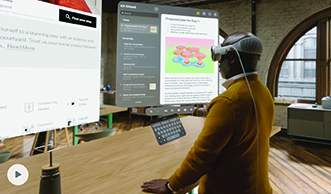 |
| Apple Vision Pro was released in February and retails for $3,500. | |
“I’m excited about the consumer aspect. I think things like Apple Vision Pro as well as Oculus and Rift and others — they’ll be the first to kind of blaze the trails of what is possible with the technology and how to incorporate things like AI and image recognition and overlays. I think we’ll see that first. We’re kind of at the precipice of that happening, especially with Apple.
“Once they’ve solved the problem of making it cheap enough that a warehouse can afford to purchase these types of headsets for all of their employees, then I think we’ll see it more integrated into the warehouse environment. Hopefully we’ll also get to a point where Apple Vision Pro doesn’t have a long cord in the battery and that it’s $500 instead of $3,500.”
THERE’S AN APP FOR THAT
Strivr, an enterprise VR platform that solves workforce training challenges for large companies such as Walmart and Bank of America, has developed an app for Apple Vision Pro that they say will leverage key features of the product to further drive advancements in enterprise learning & development by:
- Bringing learning into the natural flow of work: An uninterrupted and guided workflow with access to information in the field of view to enable higher levels of productivity.
- Delivering training into real-world environments: High-quality video pass through to enable training to take place in the physical environment where skills must be applied on the job – grocery aisles, hotel lobbies, manufacturing plants, and even at your desk.
- Enabling complete immersion for learning optimization: Immersive environments in Apple Vision Pro eliminate distractions from the outside world, allowing for full engagement during training sessions that are rare, dangerous, and expensive to replicate in the real world.
- Using AI to generate dynamic and adaptive experiences: Personalized, intuitive, realistic communication, real-time animations based on context and user input to generate more compelling experiences.
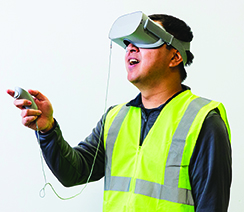 |
| Strivr has developed an app for Apple Vision Pro, and the leaders of both companies believe the business case for adoption is strong. |
Strivr Founder Derek Belch, a former college football coach who used VR to train players before launching the VR platform in 2015, says the way employees are being trained today in corporate America needs to change.
“It’s time to reinvent performance,” he said. “It’s on executives and leaders and managers to rethink how they train their workforce because people are what get jobs done. Successfully prepared people are what ultimately leads to better businesses.
“The feedback from learners says it works,” he added. “They’re engaged, they’re happy, they’re retaining more, and … some of the largest corporations in the world are doing this at scale. Virtual reality is probably in the bottom of the first inning, but it’s driving real business impact and outcomes for some of the largest companies in the world today, and it will only become more pervasive as the tech continues to evolve and enterprise and consumer adoption grows.”
GET PICKING
Most distributor warehouses use their best person to train newcomers, which, says Lucas Systems Chief Technology Officer Mark McCleary, can be an impediment to workday progress, and one that can eat up money quickly.
“If you can envision being in a VR environment, where you could learn all the mechanisms of picking products, and doing replens and packing and auditing and cycle counting, but it’s all in the virtual world. That feels like probably one of the bigger use cases for me in distribution,” said McCleary.
“The other one, which hasn’t fully matured in the last five or six years is vision picking, where an employee goes out with a list of items to pick for an order or a series of orders,” he continued. “VR would guide them to a location with the quantity to pick. Picking probably the biggest source of labor in the warehouse, because robotics really hasn’t cracked that niche of being able to pick up individual items. And so, you have to use people to do that, but there’s high turnover in the warehouse so people often can come in and be confused. Products look alike, and they may grab the wrong product, which adds up to a lot of problems. But augmented reality really gives you the opportunity, with AI and a camera on a set of AR goggles to inspect where the person is at and make sure that they’re picking the right thing. But also, to help guide them there, literally giving them directional cues to get to the right spot.”
Lori Haggart, global general manager, vision solutions, at Honeywell agrees that AR and VR technologies have the potential to solve many industrial distributor problems, chiefly around the DC’s labor shortages and pressures to deliver goods quickly and accurately to the right locations.
“AR solutions can boost worker productivity and accuracy when picking items or accounting for inventory in a DC, ultimately helping the goods to reach their destination faster,” Haggart said. “As an example, many companies have implemented barcode-decoding software on their mobile computers to turn a cameraenabled device into a barcode scanner for workers that can capture product data quickly and accurately. The software includes augmented reality plug-ins that use barcode location coordinates to visually overlay graphics and product information on the screen of the device when workers scan a barcode. This enables DC and warehouse workers to more easily verify inventory and helps increase productivity when picking and packing items for shipment.”
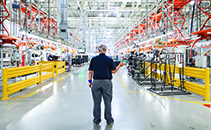 |
Lorne Fade, co-founder and COO at VR Vision Inc. in Toronto says the benefits of VR are numerous:
- Training and Skill Development: VR provides immersive, hands-on training without the risks associated with on-the-job training. For instance, employees can practice operating heavy machinery in a controlled, virtual environment without the risk of injury or danger.
- Efficiency and Accuracy in Warehousing: By simulating warehouse environments, VR helps in optimizing layout and operations, leading to increased efficiency and reduced errors in tasks like picking and placing.
- Safety and Risk Management: VR simulations can prepare workers for hazardous situations, ensuring they are well-trained to handle real-life emergencies without any risk during training.
- Remote Collaboration and Support: VR enables remote assistance and collaboration, allowing experts to guide on-site workers through complex tasks, thus saving time and travel costs.
“We’ve seen a growing trend in adopting VR for training, especially in areas like logistics, machinery operation, and safety protocols,” said Fade. “In warehouses, VR is used for layout planning and optimizing picking routes. In manufacturing, it assists in product design and assembly line simulations. We’ve seen Toyota use VR to learn how to use heavy equipment and collaborate with team members who are located across the globe. They also use it for warehouse safety procedures to ensure staff are trained appropriately for emergency procedures.”
When the time comes to evaluate AR/VR products, Fade says distributors should consider: (1) compatibility with existing systems to ensure the VR technology integrates seamlessly with your current software and hardware systems. (2) ease of use – devices should be user-friendly, requiring minimal training for employees to adapt. (3) durability and maintenance – given the industrial setting, devices should be robust and easy to maintain. (4) scalability – able to accommodate future growth and technological advancements. (5) cost-benefit analysis – consider the long-term ROI, not just the upfront costs, he says.
EASE OF USE
Haggart emphasizes that ease of use for workers is a top factor. Devices or technologies that are complicated to use are unlikely to be adopted broadly by the workforce. Solutions must also be able to integrate seamlessly with a business’s other technology investments.
On the adoption front, she added that barcode-decoding software with AR capabilities has been adopted by hundreds of companies in the transportation, logistics and warehousing sectors. “For instance, it has been integrated into handheld computers carried by warehouse workers as well as drones that fly throughout a DC to continually scan inventory,” Haggart said.
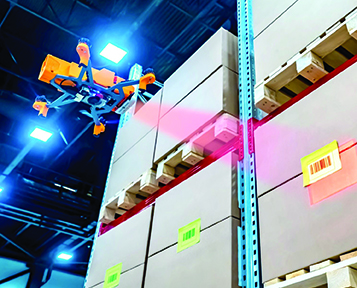 |
| Honeywell's SwiftDecoder is a vision software; in this application, a drone scans warehouse inventory. |
Honeywell’s SwiftDecoder software is being used by some of the world’s largest companies to scan millions of barcodes every day across retail, warehousing, healthcare, government and hospitality. The vision software delivers the speed, range and accuracy needed to help boost operational performance and efficiency.
SwiftDecoder allows users to acquire and process data and images quickly and reliably in complex workflows like those in the warehouse and DC. It incorporates AR and optical character recognition (OCR) technology to capture and encode information from printed text. The solution can support a wide range of devices including smartphones, tablets, payment terminals, drones and robots. The SwiftDecoder solution is also compatible with major operating systems including iOS®, Android, Windows, and Linux, and wrappers like Xamarin, Cordova and React Native.
SwiftDecoder is designed for easy integration and faster time to market with expert engineering support, tools and documentation. Together, this makes adoption easier and helps lower total integration cost.
“We understand that technology on the frontline must be very easy to use. As such, we use indicators and visual cues to support the worker through their workflows,” Haggart said. “For example, red represents negative or “does not meet” the requirement and green indicates positive or “meets the requirement.” Other visual cues include using clear wording to display the next task on a device screen; for instance, if an item is out of stock, the software would show “re-stock item” or another similar cue on the screen.
“It is even possible to automate some tasks so the worker does not have to think about their next step,” she added. “For example, we can create a task item that references a pick list so workers know what to pick in what order.”
REMOTE ASSISTANCE
At VR Vision, their Vision Portal is an advanced enterprise- grade platform tailored for enhancing VR training experiences in organizations. It serves as a comprehensive solution for scaling VR learning, offering capabilities like casting, streaming, and real-time monitoring of learning outcomes. A key feature is its remote assistance, which enables trainers to provide live support and guidance to trainees through VR devices.
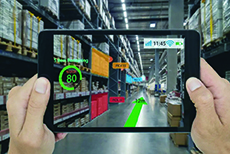 |
| VR Vision customizes solutions to align with its customers' workflows. |
The platform also includes a VR training dashboard for managing VR training deployments and detailed analytics to measure and analyze training performance in real-time. Additionally, said Fade, it supports scalable VR learning curriculums and integrates with various VR content types on the OpenXR framework.
“We focus on intuitive interface designs that are easy to navigate, even for those new to VR,” Fade said. He added that comprehensive support and training is essential for giving distribution employees the best possible user experience, ensuring smooth implementation and usage. The company’s products are also customizable to fit the specific needs and workflows of each client.
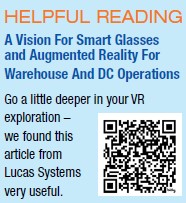 |
This article originally appeared in the March/April 2024 issue of Industrial Supply magazine. Copyright 2024, Direct Business Media.












